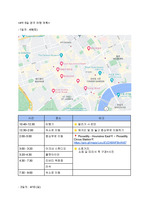The Roles and Strategies of the Regional e-Learning Centers
*대*
다운로드
장바구니
소개글
본 논문은 e-러닝의 전략과 e-러닝센터의 전략에 관한 것입니다.목차
The Roles and Strategies of the Regional e-Learning Centers for Higher Education in KoreaⅠ. Introduction
Ⅱ. Definition of e-Learning and Success Factors
Ⅲ. e-Learning Vision and Strategies in Korea
Ⅳ. The Roles and Strategy of ReLC
Ⅴ. Schemes and Conclusion
본문내용
AbstractWe are in the era of knowledge-based information society in which e-Learning is main issue. Korea has endeavored to establish a know-based society for a decade. In Korea, most K12 schools e-Learning are derived by the public sectors, such as KEDI(The Korean Educational Development Institute). On the other hand, the e-Learning for the higher education are served by the many private sectors, such as cyber universities which are established by private institution or consortium of off-line universities. Recently, we Korean have successfully set up an effective e-Learning contents sharing and development support system through regional-based university e-Learning centers which are directed by the KERIS(Korea Education and Research Information Services) and supported by the Korea Ministry of Education and Human Resources. This paper presents the strategies and policies of the regional university e-Learning centers as well as the roles of them.
Keywords: e-Learning, distance learning, e-Learning strategy, e-Learning center, cyber education, cyber university
Ⅰ. Introduction
We are living in a world where all peoples are undergoing a rapid transformation in the face of the digital information revolution. Most countries enforce to draw up nation-wide blueprints for the future of education and to create an innovative HRD (Human Resource Development) system through the application of information technology and internet to the modern education system, which is ICT (Information and Communication Technology) in education
참고 자료
ASTD(American Society for Training and Development), e-Learning Research, 2000.Cloete, E., "Electronic Education System Model," Computers & Education, Vol. 36, No. 2, 2001, pp.171-182.
Dator, J., "The Futures of Universities; Ivied Halls, Virtual Malls, or Theme Parks?," Futures, Vol. 30, Issue 7, September 1998, pp. 615-623.
Gold, J., H. Rodgers, and W. Smith, “What is the Future of the Human Resource Development Professional? A UK Perspective,” Human Resource Development International, Vol. 6, No. 4, 2003, pp. 437-456.
Goldstein, M. B., "To Be [For-Profit] Or Not to Be: What Is the Question?," Change, Vol. 32, No. 5, 2000.
Harasim, L., "Computer Learning Networks: Educational Applications of Computer Conferencing," Journal of Distance Education, Vol. 1, 1986, pp. 59-60.
Hendrik, F. and B. Serfontein, A Workable e-Learning Strategy for Distance Education in South Africa, Proceedings of IEEE International Conference on Advanced Learning Technologies, 30 Aug.-1 Sept. 2004, pp. 943 – 947.
IDC, "e-Learning: The Definition, the Practice, and the Promise," IDC Report, 2000. 10.
IDATE, "e-Learning: Challenges and Opportunities for Key Players," IDATE News, 2002. 2. 26.
Ives, B., and G. P. Learmonth, "The Information Systems as a Competitive Weapon," Communications of the ACM, Vol. 27, No. 12, 1984, pp. 1193-1201.
Jeong, D. Y. and K. S. Kim, “An Empirical Assessment of the Strategic Roles of e-Learning Center in the Community of Local Universities,” The Journal of Information System, Vol. 14, No. 2, 2005, pp. 75-79.
Kelly, M. E., "Course Teams and Institutional Design in Australian Distance Education," Distance Education, Vol. 8. No.1, 1897, pp. 106-120.
Khan, B. H., Web-based Instruction: What it is and why is it? In Kahn, B. H., Web-based Instruction Educational Technology Publications, NJ Englewood Cliffs, 1997.
Maier, P. and A. Warren, Integrating Technology in Learning and Teaching, Kogan Page, London, 2000.
McFarlan, F. W., "Information Technology Changes the Way You Compete," Harvard Business Review, Vol. 62, No. 3. 1984, pp. 98-103.
Nam, S. Z., "A Research on the Cyber University," International Conference on Information Technology and Computer Education, Jan. 1999, 152-162.
Nisar, T. M.. “e-Learning in Public Organizations,” Public Personnel Management, Vol. 33, Issue 1, 2004, pp. 79-88.
Olcott, D. and S. J. Wright, "An Institutional Support Framework for Increasing Faculty Participation in Post Secondary Distance Education." American Journal of Distance Education, Vol. 9. No.3, 1995, pp. 5-17.
Park, J. H. “e-Learning Policy in Korea,” e-Learning International Seminar 2006, Seoul, Sept. 27-29, 2006.
Parsons, G. L., "Information Technology: A New Competitive," Sloan Management Review, Vol. 25, No. 1, 1983, pp. 3-14.
Peterman, T. W., "Elements of Success at a Traditional/Virtual University: Lessons Learned from Three Years of Growth in Cyberspace," The Journal of Academic Librarianship, Vol. 26, No.1, January 2000, pp. 27-32.
Phillips, J. J., “Twelve Success Factors for Corporate Universities,” Chief Learning Office Magazine, http://www.clomedia.com, February 2004.
Porter, M., and V. E. Millar, "How Information Gives You Competitive Advantage," Harvard Business Review, Vol. 63, No. 4. 1985, pp. 149-161.
Premkumar, G. and W. R. King, "An Empirical Assessment of ISP and the Role of IS in Organization," Journal of MIS, Vol. 2, 1992, pp. 99-125.
Ryan, S., B. Scott, H. Freeman, and D. Patel, The Virtual University: The Internet and Resource-based Learning, Kogan Page, London, 2000.
Rockart, J. F., "Chief Executives Define Their Own Data Needs," Harvard Business Review, March-April, 1979, pp. 81-92.
Rockart, J. F. and A. D. Crescenzi, "Engaging Top Management in Information Technology," Sloan Management Review, Summer 1984, pp. 3-16.
Rosenberg, M. J., E-Learnig: Strategies for Delivering Knowledge in the Digital Age, McGraw-Hill, 2001.
Ruttenbur, B. W., G. C. Spickler, and S. Lurie, “eLearning: The Engine of the Knowledge Economy,” Morgan Keegan, 2000.
Stallings, D., "The Virtual University: Legitimized at Century`s End: Future Uncertain for the New Millennium," The Journal of Academic Librarianship, Vol. 26, No. 1, 2000, pp. 3-14.
Stallings, D., "The Virtual University: Organizing to Survive in the 21st Century," The Journal of Academic Librarianship, Vol. 27, No. 1, 2001, pp. 3-14.
Urban, T. A., and C. C. Weggen, Corporate e-Learning: Exploring a New Frontier, WR Hambrecht+ Co., March 2000.
W






















